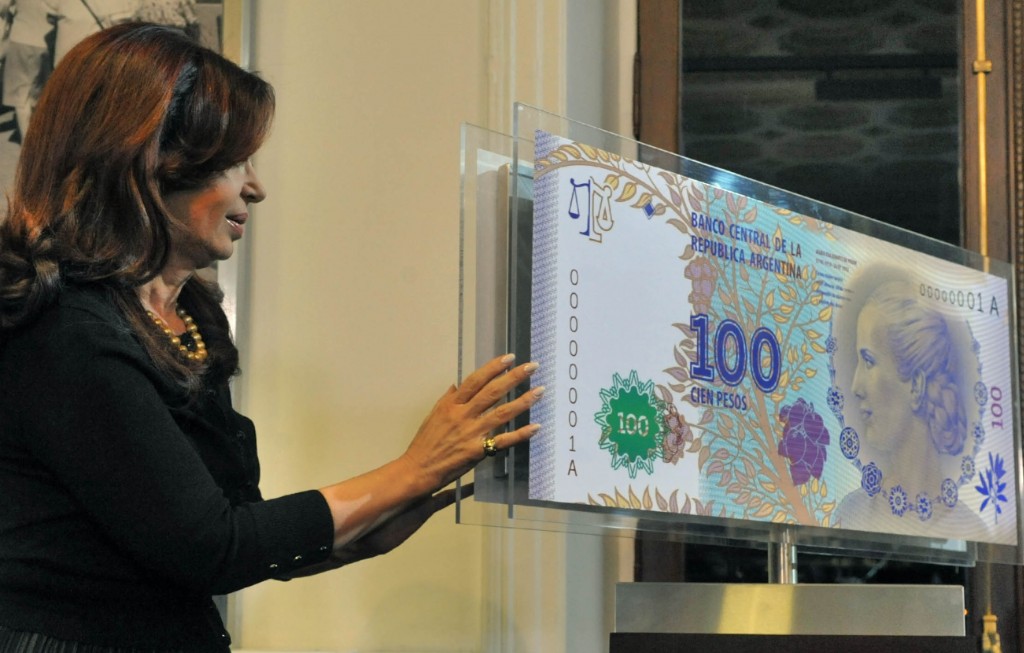July 26, 2012, was the 60th anniversary of the death of Eva Duarte de Perón (Evita); on July 25, in honor of the anniversary, President Cristina Fernandez de Kirchner presented a tribute banknote with Evita's face, replacing Julio Roca on the $100 bills.
The official page of the Casa Rosada published parts of [es] the President's speech:
La Presidenta concluyó que “este billete es reparador de nuestros propios errores, de nuestras propias equivocaciones”. “No es que Eva haya sido una santa, sino que lo que la convierte inmortal es haber sido una sencilla mujer, que se encontró con un hombre y con un pueblo”, remarcó.
The other side of the $100 bill bears the image of the Conquest of the Desert, led by Julio Roca, which meant the death of thousands of indigenous people in the year 1879.

Presentation of the 100 peso bill as a tribute to Eva Peron. Image by Casa Rosada, used under Creative Commons license CC-BY-SA
The blog Novedades numismáticas de Argentina y el mundo (Numismatic News from Argentina and the World) [es] reposed a note from El Día [es] which indicates there have been several attempts to replace Julio Roca's image, who was also President of Argentina from 1880 to 1886.
According to Teodoro Boot in the Blog del Ingeniero [es], the use of Evita's image signifies an act of social validation, as the first woman to appear on an Argentine banknote:
Uno, que tiende a entrar como un gil en esas polémicas, se maravilla del modo en que Cristina pasó de Roca (comparando con otros, un poco injustamente) y pasó de las opciones ofrecidas, para proponer o más bien recuperar otro paradigma, el de la justicia social, que en el caso de Evita supone además la reivindicación femenina.
On the other hand, the webpage Relato del Presente [es] comments on the contributions Julio Roca made to the concept of state and nation:
Porque resulta ser que Julio Argentino Roca fue el que definió la nacionalidad. Porque resulta ser que el Teniente General Roca fue el que combatió a la oligarquía porteña -nétamente mitrista- por considerarla contraria al concepto de nación. Porque resulta ser que el expresidente Roca concibió un Estado moderno, laico, independiente de la iglesia, políticamente liberal, económicamente desarrollista. Porque resulta ser que Roca pensó un Estado que colocaba al capital a su servicio, garantizando el libre desarrollo de la actividad comercial y empresarial y, al mismo tiempo, llevando a que el Estado se hiciera cargo de lo que no era productivo para ningún inversor como, entre otras cosas, la construcción de ferrocarriles en zonas improductivas.
In his blog, Daniel Mancuso [es] alludes to the phrase “I will return and I will be millions”, a phrase by Tupac Catari (who suffered death by dismemberment by the Spanish in 1781) which according to legend, Evita also used before her death:
Y como castigo, aun los que te desprecian tendrán que sostenerte y atesorarte. Pronto, una roca genocida será derribada de su sitial indigno, despeñada hacia el abismo del olvido. Era cierto, no renunciaste nunca, a pesar de 60 años de ausencia. Tus sentimientos volvieron y son millones.
However, some feel that the image of Evita will be devalued, like Roberto Barozzi in the blog El Mensajero [The Messenger] [es]:
Así, los billetes parecen estampillas conmemorativas, probablemente porque al perder valor ante la inflación se produce una depreciación que los convertirá en breve en piezas de colección.
Cristina tenía 2 opciones para recordar con dignidad a Eva Duarte de Perón:
> lanzar en su nombre un plan de recuperación del valor de la moneda, bajando la inflación; o
> imprimir con su imagen billetes de mayor denominación así los argentinos recordaban el evento y Evita duraba más tiempo del que durará en los $ 100 que ya no tienen el poder adquisitivo de cuando fueron impresos por 1ra. vez.
Thus, the banknotes look like commemorative stamps, probably because when they lose value with inflation, they will soon become collector's items.
Cristina had two options to remember Eva Duarte with dignity:
> Launch a plan in her name to restore the value of the currency, lowering inflation; or
> Print bills of a larger denomination with her image so the Argentine people will remember the event and Eva would last longer than the $100 bills that no longer have the purchasing power as when they were printed the first time.
The webpage of the newspaper Perfil.com [es] published an interview by Channel 26 [es] with the former head of the Central Bank, who thinks the image of Evita has been devalued:
“Evita era la excusa perfecta para sacar un billete de 500 pero la devalúan y la ponen en el de 100 para no admitir la inflación”, opinó el ex funcionario, sobre los nuevos billetes de 100 pesos. “Este Gobierno devalúa hasta a Eva Perón”, opinó.
On Twitter [all references are in Spanish], the tags #ChauRoca and Evita, appeared, among others. Sebastián Abrevaya (@SebasAbrevaya) also uses the phrase “I will return and I will be millions”:
@SebasAbrevaya: Efectivamente volvió y fue millones (de billetes)
#Evita#ChauRoca
Marian Villavicencia (@marianV7), alluding to the Argentine foreign exchange, asks:
@marianV7: Los $ 100 de Evita van a cotizar en el mercado oficial o en el mercado negro??
#ChauRoca
And Hernán Giardini (@HernanGiardini) makes another proposal:
@HernanGiardini: Por fin sacan al genocida Roca del billete de cien pesos!
#ChauRoca Ahora a quitar los monumentos, y cambiar las calles y ciudades
Since the new note is legal tender, the Argentine mint published [es] the security features for the bills.








1 comment